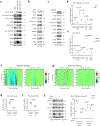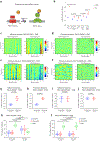PKCθ-mediated serine/threonine phosphorylations of FAK govern adhesion and protrusion dynamics within the lamellipodia of migrating breast cancer cells
- PMID: 34826547
- PMCID: PMC9019305
- DOI: 10.1016/j.canlet.2021.11.026
PKCθ-mediated serine/threonine phosphorylations of FAK govern adhesion and protrusion dynamics within the lamellipodia of migrating breast cancer cells
Abstract
The cytoskeleton and cell-matrix adhesions constitute a dynamic network that controls cellular behavior during development and cancer. The Focal Adhesion Kinase (FAK) is a central actor of these cell dynamics, promoting cell-matrix adhesion turnover and active membrane fluctuations. However, the initial steps leading to FAK activation and subsequent promotion of cell dynamics remain elusive. Here, we report that the serine/threonine kinase PKCθ participates in the initial steps of FAK activation. PKCθ, which is strongly expressed in aggressive human breast cancers, controls the dynamics of cell-matrix adhesions and active protrusions through direct FAK activation, thereby promoting cell invasion and lung metastases. Using various tools for in vitro and live cell studies, we precisely decipher the molecular mechanisms of FAK activation. PKCθ directly interacts with the FAK FERM domain to open FAK conformation through PKCθ's specific V3 domain, while phosphorylating FAK at newly identified serine/threonine residues within nascent adhesions, inducing cell dynamics and aggressive behavior. This study thus places PKCθ-directed FAK opening and phosphorylations as an original mechanism controlling dynamic, migratory, and invasive abilities of aggressive breast cancer cells, further strengthening the emerging oncogenic function of PKCθ.
Keywords: Cancer cell migration and invasion; Cell dynamics; FAK; PKCθ; Phosphorylation.
Copyright © 2021 Elsevier B.V. All rights reserved.
Conflict of interest statement
COMPETING FINANCIAL INTERESTS
The authors declare no competing financial interests.
DECLARATION OF INTERESTS
The authors declare that they have no known competing financial interests or personal relationships that could have appeared to influence the work reported in this paper.
Figures








Similar articles
-
The FAK-Arp2/3 interaction promotes leading edge advance and haptosensing by coupling nascent adhesions to lamellipodia actin.Mol Biol Cell. 2016 Apr 1;27(7):1085-100. doi: 10.1091/mbc.E15-08-0590. Epub 2016 Feb 3. Mol Biol Cell. 2016. PMID: 26842895 Free PMC article.
-
The extracellular-regulated protein kinase 5 (ERK5) enhances metastatic burden in triple-negative breast cancer through focal adhesion protein kinase (FAK)-mediated regulation of cell adhesion.Oncogene. 2021 Jun;40(23):3929-3941. doi: 10.1038/s41388-021-01798-2. Epub 2021 May 12. Oncogene. 2021. PMID: 33981002 Free PMC article.
-
LKB1 represses focal adhesion kinase (FAK) signaling via a FAK-LKB1 complex to regulate FAK site maturation and directional persistence.J Biol Chem. 2013 Jun 14;288(24):17663-74. doi: 10.1074/jbc.M112.444620. Epub 2013 May 1. J Biol Chem. 2013. PMID: 23637231 Free PMC article.
-
New insights into FAK structure and function in focal adhesions.J Cell Sci. 2022 Oct 15;135(20):jcs259089. doi: 10.1242/jcs.259089. Epub 2022 Oct 14. J Cell Sci. 2022. PMID: 36239192 Review.
-
Illuminating adhesion complexes in migrating cells: moving toward a bright future.Curr Opin Cell Biol. 2003 Oct;15(5):614-20. doi: 10.1016/s0955-0674(03)00105-4. Curr Opin Cell Biol. 2003. PMID: 14519397 Review.
Cited by
-
Functional and clinical characteristics of focal adhesion kinases in cancer progression.Front Cell Dev Biol. 2022 Nov 2;10:1040311. doi: 10.3389/fcell.2022.1040311. eCollection 2022. Front Cell Dev Biol. 2022. PMID: 36407100 Free PMC article. Review.
References
-
- Blay P et al. Protein kinase C theta is highly expressed in gastrointestinal stromal tumors but not in other mesenchymal neoplasias. Clinical cancer research : an official journal of the American Association for Cancer Research 10, 4089–4095 (2004). - PubMed
-
- Motegi A et al. PKC theta, a novel immunohistochemical marker for gastrointestinal stromal tumors (GIST), especially useful for identifying KIT-negative tumors. Pathol Int 55, 106–112 (2005). - PubMed
Publication types
MeSH terms
Substances
Grants and funding
LinkOut - more resources
Full Text Sources
Medical
Miscellaneous

